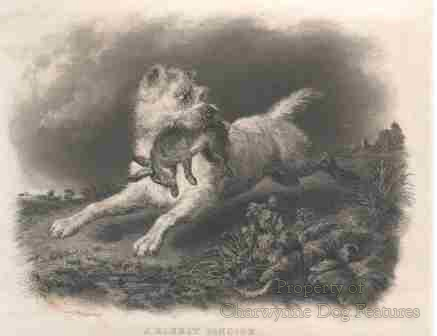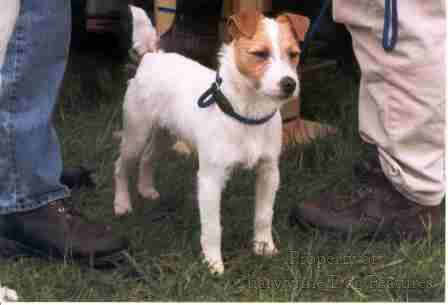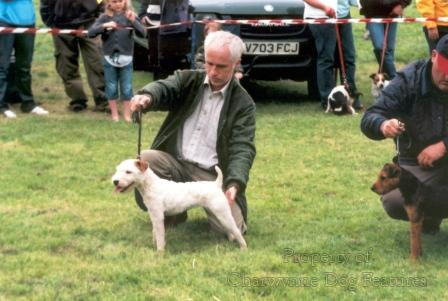235 Judging Working Terriers
JUDGING THE WORKING TERRIER
by David Hancock
 "I never see a real Fox-Terrier nowadays". - the Rev. John Russell c. 1875. "That the foxterrier of today is a great improvement, in so far as looks go, on his predecessors of forty or fifty years ago is beyond question, though whether he is better suited physically or morally for work underground is a matter of opinion". - Pierce O'Conor, "Sporting Terriers", 1926. I believe that it is entirely fair to state that of all the types of dog ruined by the effects of the Kennel Club-approved show rings the terrier group has suffered the most. This is sad for a number of reasons: firstly, the Kennel Club was founded by sportsmen, with the Rev. John Russell an early member and foxterrier judge; secondly, the breeders of those terrier breeds recognised by the KC boast of the sporting ancestry of their dogs -- and then dishonour it, and, thirdly, some quite admirable breeds of terrier have been degraded, even insulted, in this way. Discounting the Airedale, never an earth-dog more a hunting griffon, and farm dogs like the Kerry Blue and Wheaten Terriers, which were allrounders rather than specialist terriers, all show terriers should only be called full champions if they have passed an underground test. In the United States, they are conducting such tests, ranging from 'Introduction to Quarry' and 'Junior Earthdog' to 'Senior Earthdog' and 'Master Earthdog'. To date I know of no master earthdog tests being held but just under ten dogs hold the senior earthdog title. In the introduction test, the terrier (or working Dachshund) has two minutes to enter a ten foot tunnel, negotiate a 90 degree turn and 'work' the quarry for 30 seconds. The American enthusiasts say that "you put a dog down the hole but you get a terrier out of it". In the master earthdog test, acting in a brace, a dog has to follow a 100 foot scent trail to a hole, which is intentionally a false one, investigate the false den without giving tongue, then navigate 30 feet of tunnel, three 90 degree turns, a false exit, a constriction point and an obstacle. Seventy years ago, Pierce O'Conor was
"I never see a real Fox-Terrier nowadays". - the Rev. John Russell c. 1875. "That the foxterrier of today is a great improvement, in so far as looks go, on his predecessors of forty or fifty years ago is beyond question, though whether he is better suited physically or morally for work underground is a matter of opinion". - Pierce O'Conor, "Sporting Terriers", 1926. I believe that it is entirely fair to state that of all the types of dog ruined by the effects of the Kennel Club-approved show rings the terrier group has suffered the most. This is sad for a number of reasons: firstly, the Kennel Club was founded by sportsmen, with the Rev. John Russell an early member and foxterrier judge; secondly, the breeders of those terrier breeds recognised by the KC boast of the sporting ancestry of their dogs -- and then dishonour it, and, thirdly, some quite admirable breeds of terrier have been degraded, even insulted, in this way. Discounting the Airedale, never an earth-dog more a hunting griffon, and farm dogs like the Kerry Blue and Wheaten Terriers, which were allrounders rather than specialist terriers, all show terriers should only be called full champions if they have passed an underground test. In the United States, they are conducting such tests, ranging from 'Introduction to Quarry' and 'Junior Earthdog' to 'Senior Earthdog' and 'Master Earthdog'. To date I know of no master earthdog tests being held but just under ten dogs hold the senior earthdog title. In the introduction test, the terrier (or working Dachshund) has two minutes to enter a ten foot tunnel, negotiate a 90 degree turn and 'work' the quarry for 30 seconds. The American enthusiasts say that "you put a dog down the hole but you get a terrier out of it". In the master earthdog test, acting in a brace, a dog has to follow a 100 foot scent trail to a hole, which is intentionally a false one, investigate the false den without giving tongue, then navigate 30 feet of tunnel, three 90 degree turns, a false exit, a constriction point and an obstacle. Seventy years ago, Pierce O'Conor was  advocating something similar. He described the French apparatus for trying terriers: a wooden conduit 7½" wide, sunk in the earth, with passing chambers, just over 50 feet long. Terrier-testing underground is so much more a basis for judging than any 'beauty show'. It tests, however artificially, the working instinct and character of the dog. But even beauty shows should end up rewarding a working physique rather than one cosmetically appealing. But what should 'working appeal' be based on? The original working foxterriers were barrel-chested and featured a fairly straight stifle and hock; the longer tibia and well-bent hock of the show ring terrier of today is not much use underground. But an even bigger difference lies in the shoulder angulation and depth of chest. Show foxterriers feature without exception upright shoulders and slab-sided but deep chests; neither of these physical attributes help an earthdog. Nor does the short back of the pedigree foxterrier, which reduces flexibility and overall suppleness. It does however produce a more compact-looking showy type of dog. The craze for long heads in show terriers, exemplified most clearly in the smooth foxterrier, is rooted in the misguided belief that length gives power. You also hear the expression: "plenty of heart room", which is strange when the heart doesn't actually change size when the dog is exerting itself. Plenty of lung room is desirable, especially in terriers which run with the hounds. But it is rib-space which gives a dog lung room, not depth of chest. I have heard terrier show judges fault a very muscular terrier, used to hard exercise, for being 'loaded at the shoulders' when the fortunate dog had developed muscle which projected on the outside of its shoulders. Any individual accepting a judging appointment should question their own capability and 'eye for a dog' before proceeding. Symmetry is important in most working animals; in a foxterrier measuring two feet from the top of its head to the ground, its front should cover not more than eight inches in width, a proportion of at least 1 in 3. In his informative book "The Popular Foxterrier" of 1950, Rosslyn Bruce, who drew on the knowledge of the Rev. A.J.Skinner, a breeder of working and show terriers, makes great play of correct proportions. His best all-purpose terrier came out showing the measurements indicated in Fig 1. He believed that height at the withers should equal the length of the dog, i.e. 1 - 2 should equal 3 - 5 in Fig 2. He also argued that the depth of chest (3 - 4) should equal leg length (4 - 5). He sensibly argued against 'square' foxterriers (see Fig 3), stating this encouraged upright shoulders, too short a back and faulty necks. He favoured the build illustrated in Fig 4, considering this provided good reach of neck, flexibility of body and correct shoulder placement. As dog-show exhibitors without working experience gained the ascendancy, these arguments were forgotten. In time, a judge like MacDonald Daly, despite owning coursing greyhounds, was advocating foxterriers with the physical desiderata set out in Fig 5. The
advocating something similar. He described the French apparatus for trying terriers: a wooden conduit 7½" wide, sunk in the earth, with passing chambers, just over 50 feet long. Terrier-testing underground is so much more a basis for judging than any 'beauty show'. It tests, however artificially, the working instinct and character of the dog. But even beauty shows should end up rewarding a working physique rather than one cosmetically appealing. But what should 'working appeal' be based on? The original working foxterriers were barrel-chested and featured a fairly straight stifle and hock; the longer tibia and well-bent hock of the show ring terrier of today is not much use underground. But an even bigger difference lies in the shoulder angulation and depth of chest. Show foxterriers feature without exception upright shoulders and slab-sided but deep chests; neither of these physical attributes help an earthdog. Nor does the short back of the pedigree foxterrier, which reduces flexibility and overall suppleness. It does however produce a more compact-looking showy type of dog. The craze for long heads in show terriers, exemplified most clearly in the smooth foxterrier, is rooted in the misguided belief that length gives power. You also hear the expression: "plenty of heart room", which is strange when the heart doesn't actually change size when the dog is exerting itself. Plenty of lung room is desirable, especially in terriers which run with the hounds. But it is rib-space which gives a dog lung room, not depth of chest. I have heard terrier show judges fault a very muscular terrier, used to hard exercise, for being 'loaded at the shoulders' when the fortunate dog had developed muscle which projected on the outside of its shoulders. Any individual accepting a judging appointment should question their own capability and 'eye for a dog' before proceeding. Symmetry is important in most working animals; in a foxterrier measuring two feet from the top of its head to the ground, its front should cover not more than eight inches in width, a proportion of at least 1 in 3. In his informative book "The Popular Foxterrier" of 1950, Rosslyn Bruce, who drew on the knowledge of the Rev. A.J.Skinner, a breeder of working and show terriers, makes great play of correct proportions. His best all-purpose terrier came out showing the measurements indicated in Fig 1. He believed that height at the withers should equal the length of the dog, i.e. 1 - 2 should equal 3 - 5 in Fig 2. He also argued that the depth of chest (3 - 4) should equal leg length (4 - 5). He sensibly argued against 'square' foxterriers (see Fig 3), stating this encouraged upright shoulders, too short a back and faulty necks. He favoured the build illustrated in Fig 4, considering this provided good reach of neck, flexibility of body and correct shoulder placement. As dog-show exhibitors without working experience gained the ascendancy, these arguments were forgotten. In time, a judge like MacDonald Daly, despite owning coursing greyhounds, was advocating foxterriers with the physical desiderata set out in Fig 5. The  long muzzle, short back and upright shoulders are easily spotted and sadly are now the norm, held as the perfect earthdog blueprint, the ideal anatomy for a sporting terrier! Working terrier enthusiasts will never show great interest in precise measurements, exact proportions or wordy descriptions of anatomical features. But balance, symmetry, correct proportions and physical soundness really do affect function and therefore performance in a hunting animal. Terrier show judges may prefer to judge entirely by eye and experience, but is this enough? A seminar of working terrier judges to bring on the younger judges would surely be of value. It would be interesting to hear, should that happen, what terrier show judges' decisions are being based on. Pedigree livestock are still judged to a scale of points; pedigree dogs no longer are. Subjective judgements can bring fine differences of opinion to the fore. But for a working terrier to win a prize with upright shoulders, splay feet, a wry mouth and no lung room, as I witnessed last summer, is more than depressing. If countrymen can't judge a dog these days, what hope for townee judges at Kennel Club shows?
long muzzle, short back and upright shoulders are easily spotted and sadly are now the norm, held as the perfect earthdog blueprint, the ideal anatomy for a sporting terrier! Working terrier enthusiasts will never show great interest in precise measurements, exact proportions or wordy descriptions of anatomical features. But balance, symmetry, correct proportions and physical soundness really do affect function and therefore performance in a hunting animal. Terrier show judges may prefer to judge entirely by eye and experience, but is this enough? A seminar of working terrier judges to bring on the younger judges would surely be of value. It would be interesting to hear, should that happen, what terrier show judges' decisions are being based on. Pedigree livestock are still judged to a scale of points; pedigree dogs no longer are. Subjective judgements can bring fine differences of opinion to the fore. But for a working terrier to win a prize with upright shoulders, splay feet, a wry mouth and no lung room, as I witnessed last summer, is more than depressing. If countrymen can't judge a dog these days, what hope for townee judges at Kennel Club shows?